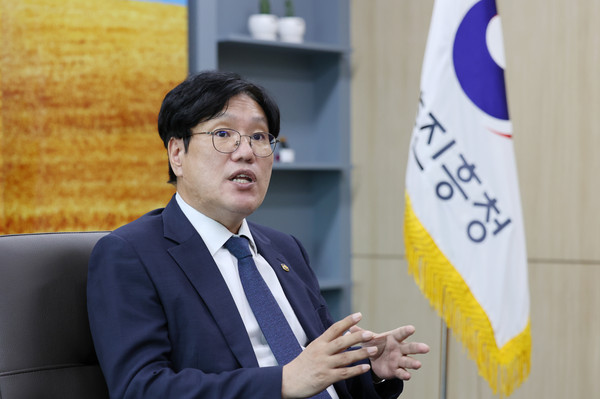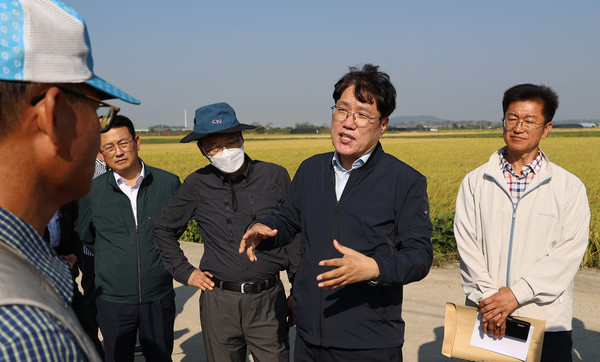Says Administrator Cho Chae-ho of the Rural Development Administration (RDA)
By Feature Editor Kim Hyung-dae
The Rural Development Administration (RDA) is celebrating its 61st anniversary this year. Launched on April 1, 1962, the year when the First Five-Year Plan for Economic Development began, the agency has served as the leader of Korea's agricultural revolution.
It has taken the lead in overcoming the food-insecure “barley hill” period, and has contributed to the eradication of hunger not only in Korea but also in poor countries abroad by improving agricultural varieties and developing agricultural technologies.

When President Park Chung-hee launched the May 16 Revolution in 1961, he made a revolutionary pledge to urgently resolve the people's livelihoods that are on the brink of despair and hunger.
At the time, Korea was a poor country with a per capita national income of $120, the streets were full of unemployed people.
As a concrete way of realizing economic development, President Park guided idle labor to factories, stimulating the secondary industry, while aiming to transform Korea into a major exporter and importer, and improved productivity in rural areas by developing agricultural technology and improving varieties.
The Korea Post media interviewed Cho Chae-ho, the 31st administrator of the 61-year-old agency, about the organization's history and its blueprint for the future.

Building a stable production base
Question: Please explain the RDA’s functions and roles.
Answer: Since its establishment, the RDA has focused on research and development of science and technology related to agriculture, farmers, and rural areas, training of rural leaders, and education. And it has contributed to the development of the national economy and improvement of the quality of life of the people by establishing a stable production base for national food.
If we categorize the past 61 years into periods,
1) In the 1970s, the country completed the Green Revolution by growing its own rice, Tongil (Korean word for reunification) Rice. Through the development of rice varieties, we contributed to food self-sufficiency by developing and distributing “Tongil Rice,” a high-yielding variety.
2) In the 1980s, we achieved the White Revolution by developing greenhouse technology to overcome climatic conditions and enable all-weather agriculture.
3) In the 1990s, we improved the quality of our agricultural products and strengthened the improvement of varieties, such as developing hydroponic cultivation technology, fostering luxury Korean beef, and improving the quality of fruit trees.
4) In the 2000s, we focused our efforts on securing international competitiveness by developing strawberry varieties in response to the market opening system.
5) In the 2010s, the agency has been striving to converge with various fields of agriculture, such as expanding bio-agricultural technology and implementing smart agriculture using ICT technology.
The agency, which has been at the forefront of solving food problems, has reset a new vision for the next 60 years and has selected a brand and catchphrase to foster the dreams of tomorrow.
With the catchphrase "Smart agriculture, Attractive rural communities," the RDA is responding to the new era by focusing its future mission (role) on RICE (Research & Development, Information, Change, Extension).

K-Rice Belt project in Africa
Q: Foreign countries are very interested in K-agriculture technology, so how will you respond to international exchanges and overseas cooperation projects in the future?
A: We have been committed to using our technology and know-how to achieve the universal human values of ending hunger and poverty. We will continue to expand these efforts in the future.
We currently collaborate with more than 120 research institutes in more than 50 countries and operate KOPIA (Korea Partnership for Innovation of Agriculture) centers in 23 countries. (Vietnam, Uganda, Nicaragua, etc.)
In terms of overseas business plans, we have set sustainable development goals and are fulfilling our role as a global pivotal country to achieve them.
In addition, we are working to establish a K-Rice Belt in Africa, which was announced at the G7 meeting, to develop locally adaptable rice varieties, produce seeds, and strengthen human resources.
Q: Currently, rural areas are suffering from a labor shortage. Accordingly, automation of agricultural mechanization is an urgent need, is there a solution?
A: At present, the mechanization rate of field agriculture is 63.3% as of 2022, and the mechanization rate of paddy agriculture is 99.3%. In the future, we are directing more research towards generalization, multi-tasking, and high-performance that can be applied in the field, and we expect good results.
In addition, we will focus our support on developing machines for labor-intensive fields such as sowing and harvesting. Our aim is to achieve a mechanization rate of 77.5% by 2026.
Q: What are your plans to encourage young people to settle in rural areas in a stable manner?
A: Currently, the rural population is becoming more imbalanced due to the aging population and the rural exodus of young people.
The aging rate is expected to rise to 76.1% by 2040, so extraordinary measures are required.
The solution is to provide customized technical support and professional development to support individuals in settling succeessfully into farming. More than 10,000 prospective farmers will be supported to settle into farming.
It will also carry out a modeling project of leading farm technology transfer and provide information on "smart young farmers" by providing customized information to more than 10,000 prospective farmers and young farmers every month.
Q: Please tell us about the RDA's blueprint for the future.
A: We plan to pay more attention to and support overseas business.
We will contribute to the achievement of the UNSDGs (Sustainable Development Goal) and strengthen our role as a global pivotal country.
In particular, we will focus on creating universal value by eradicating poverty and ending hunger, as well as contributing innovative technologies for strategic crops to increase food production so that no one goes hungry.
In the past, Korea has valuable experience in overcoming the serious food shortage period and shaking off poverty, so we have the ability to do this better than any other country.

